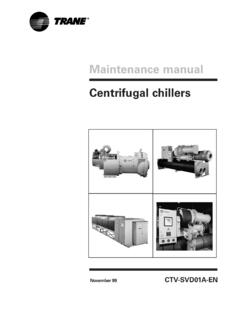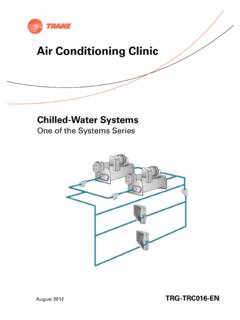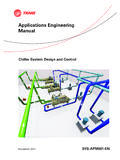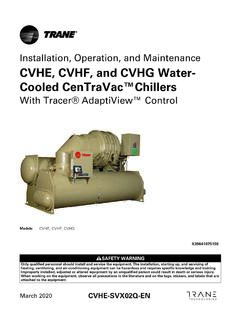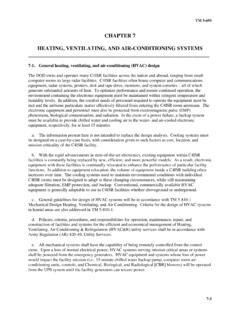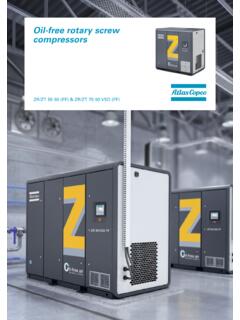Transcription of Centrifugal Water Chillers
1 Air Conditioning Clinic Centrifugal Water Chillers One of the Equipment Series July 2012 TRG-TRC010-EN. Centrifugal Water Chillers One of the Equipment Series A publication of Trane Preface Centrifugal Water Chillers A Trane Air Conditioning Clinic Figure 1. Trane believes that it is incumbent on manufacturers to serve the industry by regularly disseminating information gathered through laboratory research, testing programs, and field experience. The Trane Air Conditioning Clinic series is one means of knowledge sharing. It's intended to acquaint a nontechnical audience with various fundamental aspects of heating, ventilating, and air conditioning. We've taken special care to make the clinic as uncommercial and straightforward as possible. Illustrations of Trane products only appear in cases where they help convey the message contained in the accompanying text.
2 This particular clinic introduces the concept of Centrifugal Water Chillers . 1999 Trane. All rights reserved ii TRG-TRC010-EN. Contents Introduction .. 1. period one Components .. 3. Compressor .. 4. Condenser .. 7. Expansion Device .. 8. Economizer .. 9. Evaporator .. 11. Motor .. 12. Controls and Starter .. 13. period two Refrigeration Cycle .. 15. Refrigerants .. 19. Purge System .. 20. period three Compressor Capacity Control .. 22. period four Maintenance Considerations .. 30. period five Application Considerations .. 36. Condensing Temperature Control .. 37. Constant or Variable Evaporator Water Flow .. 39. Short Evaporator- Water Loops .. 40. Heat Recovery .. 42. Free Cooling .. 44. Equipment Certification Standards .. 46. period six Review .. 48. Quiz .. 52. Answers .. 54. Glossary .. 55. TRG-TRC010-EN iii iv TRG-TRC010-EN.
3 Introduction notes Chilled Water System Figure 2. Water Chillers are used in a variety of air conditioning and process cooling applications. They are used to make cold Water that can be transported throughout a facility using pumps and pipes. This cold Water can be passed through the tubes of coils to cool the air in an air conditioning application, or it can provide cooling for a manufacturing or industrial process. Systems that employ Water Chillers are commonly called chilled Water systems. absorption Centrifugal helical-rotary Figure 3. There are several types of Water Chillers . They differ from each other based on the refrigeration cycle or the type of compressor they use. Absorption Water Chillers make use of the absorption refrigeration cycle and do not have a mechanical compressor involved in the refrigeration cycle.
4 TRG-TRC010-EN 1. Introduction notes Water Chillers using the vapor-compression refrigeration cycle vary by the type of compressor used. Reciprocating and scroll compressors are typically used in small Chillers . Helical-rotary (or screw) compressors are typically used in medium-sized Chillers . Centrifugal compressors are typically used in large Chillers . As mentioned earlier, this particular clinic discusses Centrifugal Water Chillers . Centrifugal Water Chillers Figure 4. Centrifugal Water Chillers can also be divided into two types based on the method used to reject heat to the atmosphere: Water - cooled or air- cooled . Since most Centrifugal Chillers are Water - cooled , they are the primary focus of this clinic. Water - cooled Centrifugal Chillers are generally available from 100 to 3,000. tons [350 to 10,500 kW] as prefabricated machines, and up to 8,500 tons [30,000 kW] as built-up machines.
5 2 TRG-TRC010-EN. period one Components notes Centrifugal Water Chillers period one Components Figure 5. Many of the components of the Centrifugal Water chiller are similar to those of other chiller types. components of a Centrifugal Water chiller compressor motor condenser starter control panel evaporator Figure 6. This particular Centrifugal Water chiller makes use of a shell-and-tube evaporator where refrigerant absorbs heat from the Water flowing through the tubes. The compressor is made up of 1 or more Centrifugal impellers. A second shell-and-tube heat exchanger serves as the Water - cooled condenser, where refrigerant is condensed inside the shell and Water flows inside tubes. Refrigerant is metered through the system using an expansion device such as a fixed orifice plate. An economizer can be used to enhance the efficiency of a chiller with multiple compressor impellers.
6 A control panel is also provided on the chiller and a starter is either mounted on the chiller or located remotely. TRG-TRC010-EN 3. period one Components notes Compressor Figure 7. Compressor The Centrifugal compressor uses the principle of dynamic compression, which involves converting energy from one form to another, to increase the pressure and temperature of the refrigerant. It converts kinetic energy to static energy. Impeller blades Figure 8. The core component of a Centrifugal compressor is the rotating impeller. The center, or eye, of the impeller is fitted with blades that draw refrigerant vapor into radial passages that are internal to the impeller body. 4 TRG-TRC010-EN. period one Components notes Centrifugal Compressor volute diffuser passage impeller passages Figure 9. The rotation of the impeller causes the refrigerant vapor to accelerate within the impeller passages, increasing its velocity and kinetic energy.
7 The accelerated refrigerant vapor leaves the impeller and enters the diffuser passages. These passages start out small and become larger as the refrigerant travels through them. As the size of the diffuser passages increases, the velocity, and therefore the kinetic energy, of the refrigerant decreases. The first law of thermodynamics states that energy is not destroyed only converted from one form to another. Thus, the refrigerant's kinetic energy is converted to static energy or static pressure. Refrigerant, now at a higher pressure, collects in a larger space around the perimeter of the compressor called the volute. The volute also becomes larger as the refrigerant travels through it. Again, as the size of the volute increases, the kinetic energy is converted to static pressure. Due to its pressure and temperature, the refrigerant leaving the compressor is in a condition that allows its heat to be rejected from the chiller .
8 TRG-TRC010-EN 5. period one Components notes Centrifugal compressor Energy Conversion refrigerant enters diffuser velocity refrigerant refrigerant enters volute static pressure enters impeller path through compressor Figure 10. Again, in the passages of the rotating impeller, the refrigerant vapor accelerates, increasing its velocity and kinetic energy. As the area increases in the diffuser passages, the velocity, and therefore the kinetic energy, of the refrigerant decreases. This reduction in kinetic energy is offset by an increase in the refrigerant's static energy or static pressure. Finally, the high pressure refrigerant collects in the volute around the perimeter of the compressor, where further energy conversion takes place. The resulting pressure and temperature of the refrigerant is now high enough that its heat can be rejected from the chiller .
9 Multistage Compressor Figure 11. Centrifugal compressors use 1 or more impellers to compress the refrigerant. A. multistage compressor uses 2 or 3 impellers to increase the pressure of the refrigerant in steps instead of performing the task within a single impeller. Compressed refrigerant vapor travels from the outlet of the first-stage compressor impeller to the inlet of the second-stage compressor impeller. After 6 TRG-TRC010-EN. period one Components notes the accelerated refrigerant vapor leaves the last impeller, it collects in the compressor volute and travels on to the condenser. Condenser refrigerant vapor baffle cooling tower Water liquid tube refrigerant bundle Figure 12. Condenser The high-pressure refrigerant vapor is discharged from the compressor into a heat exchanger that acts as a condenser.
10 In a Water - cooled condenser, Water is pumped through the tubes of the shell- and-tube heat exchanger while refrigerant vapor fills the shell space surrounding the tube bundle. A baffle inside the condenser helps distribute the refrigerant evenly. As heat transfers from the hot, high-pressure refrigerant vapor to the Water , refrigerant condenses on the tube surfaces. Cooling Water flows first through the lower tubes and then through the upper tubes. This produces a nearly constant temperature difference between the downward-moving refrigerant and the tube surfaces, resulting in a uniform heat transfer rate within the tube bundle. Condensed liquid refrigerant collects in the bottom of the shell and flows through the liquid line to the expansion devices and economizer. TRG-TRC010-EN 7. period one Components notes expansion device Orifice Plates orifice plates to evaporator H1.

